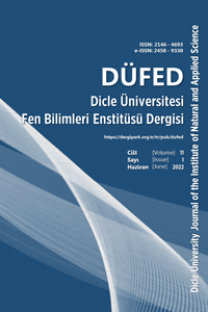Ceratophyllum demersum L. Tilki kuyruğu bitkisi kullanılarak atıksulardan bakır metalinin akümülasyonu
Bu çalışmada toksik metal iyonu olan bakır ağır metalinin suculeko sistemlerde yayılış gösteren Ceratophyllum submersum bitkisinin değişen zamana ve konsantrasyona bağlı biyo akümülasyon yeterlilikleri test edilmiştir. Bitkiler laboratuvar şartlarında bakır metalinin stok solusyonlarından 1.0,3.0,5.0 and 7.0 mg/L konsantrasyonlarda hazırlanan metal çözeltisiyle, belli zaman peryodlarında 24, 48 ve 72saat muamele edilmiştir. Veriler değerlendirildiğinde bitkinin farklı konsantrasyonlarda bakırın farklı sürelerde akümüle ettiği atomic absorbsiyon spektrofotometresiyle ölçülmüştür.Minimum uzaklaştırma 2.2 g tazeagırlıkta 0.1 ppm konsantrasyonda bakır metali, 24 saat sonra4.54 µg/g bakır ortamdan uzaklaştırlmaktadır. Maksimum uzaklaştırma 48 saat sonra 4.0 ppm de 1.8 g ağırlıkta yaş bitkiyle 92.13 µg/g
Accumulation of copper metal from wastewater by using Ceratophyllum demersum L.
In this study, the bioaccumulation sufficiency of plant Ceratophyllum submersum L. which is distributed in aquatic ecosystems against toxic metal ion was tested. In laboratory condition, plant was exposed to prepared stock solution of copper metal 1,0; 3,0;5,0; 5,0 and 7,0 mg/L concentration metal solutions in certain periods 24, 48, and72 hours and changing amount of accumulation of plants in depending on time and concentration was measured by atomic absorption spectrometer. The minimum uptake at 2.2 g fresh weight and 0.1 ppm concentration of copper metal was 4.54 µg/g of copper after 24 hours. And the maximum uptake at 1.8 g fresh weight and 4.0 ppm concentration was 92.13 µg/g after 48 hours. The minimum uptake at2.2 g fresh weight plant exposed to 0.1 ppm concentration of Cu+2 solution after 24 hours, the plant uptake was 4.54µg/g Cu+2. The maximum uptake at 1.8 g fresh weight plant exposed to 4.0 ppm concentration Cu+2 solutionafter 48 hours, the plant uptake was 92.13 µg/g Cu+2.
Keywords:
Accumulation, Cerataphyllumdemersum, Copper Heavy metal,
___
Y. Kara, D. Başaran D, Ç. Işıkalan (2009). The studies of cleaning heavy metal Mn2+ accumulatedwith Nasturtiumofficinale in water by the method of biosorption. Asian Journal Chemistry,Vol.21, pp.1176-1180.A. Zeytunluoglu, Y. Kara (2007). Bioaccumulation of toxic Metals (Cd and Cu) by Groenlandiadensa (L.) fourr. Bullentin of Environmental Contamination and Toxicology, Vol.79,pp. 483-582.
V. Okumuş, D. Basaran, A. Onay (2010). Heavy metal biosorption characteristics of the submerged aquatic plant (Nasturtiumofficinale). AsianJournal of Chemistry,Vol.22,pp.455-460.
A. Zayed, S. Gowthaman, N. Terry (1998). Phytoaccumulation of trace elements by wetland plants, I. Duckweed.Journal Environmental Quality, Vol.27,pp. 715-721.
Y.L. Zhu, A.M. Zayed, J.H. Qian, M. Souza, N.Terry (1999). Phytoaccumulation of trace elements by wetland plants.II. Waterhyacinth. Journal Environmental Quality, Vol.28, pp.339- 344.
E. Lesagea, C. Mundia, D.P. L. Rousseaub, A.M.K. Van de Moortela, G. DuLainga, E. Meersa, F.M. G. Tacka, N. De Pauwcand M.G. Verloo (2007). Sorption of Co, Cu, Ni and Znfrom industrialef fluents by the submerged aquaticmacrophyte Myriophyllumspicatum L. Ecological Engineering,Vol.30,pp.320-325.
T. Akar, S. Tunali (2006). Biosorption characteristics of Aspergillusflavus biomassforremoval of Pb(II) and Cu(II) ions from an aqueous solution. Bioresource Technology, Vol.97,pp.1780-1787.
U.N. Rai, S. Sinha, R.D. Tripathi, P. Chandra (1995).Waste water treatabilitypotential of some aquatic macrophytes: Removal of heavy metals. Ecology Engineering,Vol.5,pp.5-12.
R. Chandra, Y. Sangeeta (2011). Phytoremediation of CD, CR, CU, MN, FE, NI, PB and ZN from Aqueous Solution Using Phragmites Cummunis, Typha Angustifolia and Cyperus Esculentus. International Journal Phytoremedation. Vol.13,pp.580-591.
A.K. Hegazy, N.T. Abdel Ghani, A.G. El-Chaghaby (2011). Phytoremediation of industrial wastewater potentiality by Typha domingensis. International Journal Environmental Science and Technology, Vol.8(3), pp.639- 648.
- ISSN: 2146-4693
- Yayın Aralığı: Yılda 2 Sayı
- Başlangıç: 2012
- Yayıncı: Dicle Üniversitesi
Sayıdaki Diğer Makaleler
Bazı Süs Biberi Genotiplerinin Tohumluk Bitki Özellikleri ve Tohum Çıkış Performansları
Kahramanmaraş İli Chrysopidae Neuroptera familyası türleri üzerinde faunistik çalışmalar
Hakan BOZDOĞAN, Cengiz BAHADIROĞLU
Al/ZnO/p-Si/Al Schottky Diyotunun Güneş Pili Uygulamaları İçin Mikroelektronik Parametreleri
M BENHALİLİBA, Ys OCAK, H MOKHTARİ, Ce BENOUİS, Ms AİDA
Çift-Melez F1 Döl Kuşağında Birinci El Kütlü Pamuk Oranının Kalıtımı
Remzi EKİNCİ, Sema BAŞBAĞ, Oktay GENÇER
Soyada Tuzluluk stresinin çimlenme ve fide gelişimi üzerine fizyolojik tepkilerinin saptanması
Ayman ELSABAGH, Abd Elhamid OMAR, Hirofumi SANEOKA, Celaleddin BARUTÇULAR
